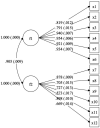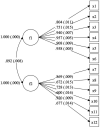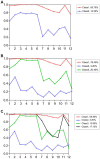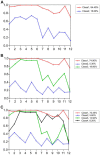Purely positive or discriminatorily positive? The development of two-factor attitudes toward lesbians and gay men scales
- PMID: 37457102
- PMCID: PMC10349374
- DOI: 10.3389/fpsyg.2023.1211282
Purely positive or discriminatorily positive? The development of two-factor attitudes toward lesbians and gay men scales
Abstract
Unidimensional bipolar scales based on prejudice against homosexuality neglect the effect of preference for heterosexuality on attitudes toward homosexuality. Additionally, the term "homosexuality" used in these scales may compromise their validity. The current study uses person-centered and variable-centered approaches to examine the structure and classes of attitudes toward lesbians and gay men. In Study 1, we developed the Two-factor Attitudes toward Lesbians and Gay Men Scales, which have acceptable reliability and validity. The results obtained through variable-centered approaches suggested that a model comprising two factors (prejudice against homosexuality and preference for heterosexuality) was ideal. In Study 2, we explored the classes of attitudes toward lesbians and gay men through latent class analysis. The results supported a model containing three classes (purely positive, discriminatorily positive, and negative). This study validates a two-factor structure of attitudes toward lesbians and gay men and distinguishes between purely positive and discriminatorily positive attitudes, providing an important reference for future research and interventions to promote public attitudes toward lesbians and gay men.
Keywords: attitudes toward lesbians/gay men; latent class analysis; reliability; scales; validity.
Copyright © 2023 Guo, Fang and Wen.
Conflict of interest statement
The authors declare that the research was conducted in the absence of any commercial or financial relationships that could be construed as a potential conflict of interest.
Figures




Similar articles
-
Attitudes of future physical education teachers in Turkey toward lesbians and gay men.Psychol Rep. 2012 Dec;111(3):765-75. doi: 10.2466/11.06.21.PR0.111.6.765-775. Psychol Rep. 2012. PMID: 23402046
-
Using Scenarios for Measuring the Affective and Behavioral Components of Attitudes Toward Lesbians and Gay Men: Validation of the SABA Scale.Arch Sex Behav. 2020 Jul;49(5):1645-1669. doi: 10.1007/s10508-020-01653-7. Epub 2020 May 6. Arch Sex Behav. 2020. PMID: 32378075
-
Implicit and explicit attitudes toward gay males and lesbians among heterosexual males and females.J Soc Psychol. 2013 May-Jun;153(3):351-74. doi: 10.1080/00224545.2012.739581. J Soc Psychol. 2013. PMID: 23724704
-
Beyond "homophobia": a social psychological perspective on attitudes toward lesbians and gay men.J Homosex. 1984 Fall;10(1-2):1-21. doi: 10.1300/J082v10n01_01. J Homosex. 1984. PMID: 6084028 Review.
-
Assessing the applicability of e-therapies for depression, anxiety, and other mood disorders among lesbians and gay men: analysis of 24 web- and mobile phone-based self-help interventions.J Med Internet Res. 2014 Jul 3;16(7):e166. doi: 10.2196/jmir.3529. J Med Internet Res. 2014. PMID: 24996000 Free PMC article. Review.
References
-
- Bai L., Xu Z., Tang H. (2013). Gender norm and male homosexual identity. Chin. J. Hum. Sex. 22, 78–83. doi: 10.3969/j.issn.1672-1993.2013.03.025 - DOI
-
- Cheng F. K. (2018). Dilemmas of Chinese lesbian youths in contemporary mainland China. Sex. Cul. 22, 190–208. doi: 10.1007/s12119-017-9460-8 - DOI
-
- Clausell E., Fiske S. T. (2005). When do subgroup parts add up to the stereotypic whole? Mixed stereotype content for gay male subgroups explains overall ratings. Soc. Cogn. 23, 161–181. doi: 10.1521/soco.23.2.161.65626 - DOI
LinkOut - more resources
Full Text Sources

